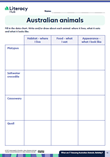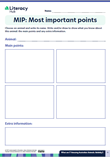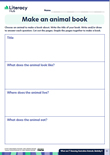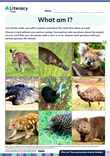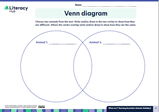What am I? Amazing Australian Animals
This question and answer puzzle text highlights the amazing features and behaviours of four unique Australian animals (platypus, saltwater crocodile, cassowary and quoll).
Back to the shared reading overview page
Text download
What am I? Amazing Australian Animals as PDF (24.3MB) (opens in new window)
What am I? Amazing Australian Animals as PowerPoint slideshow (16.9MB) (download)
Printable worksheets
|
|
|
|
|
| Australian animals data chart (79KB) | MIP: Most important points (79KB) | Make an animal book (79KB) | |
|
|
|

Teaching & learning sequence
This teaching and learning sequence outlines classroom strategies for What am I? Amazing Australian Animals, including:
- ways to incorporate the ‘Big Six’ core elements of reading development
- fun, engaging and adaptable student activities for a diverse range of abilities
- links to the Australian Curriculum.
| Text features | Cross-curriculum links to the Australian Curriculum |
|

First read
As a whole group, enjoy sharing the text and learning together.
Engage
Explain that some animals are only found living in the wild in Australia. These animals are native to Australia and we call them Australian animals. Support students with English as an additional language or dialect (EAL/D) by viewing images of Australian animals online, and discussing the names of each animal.
Talk to the students about an Australian animal that they find interesting, and why.
Have students turn and talk with their partner about the Australian animals they know. Discuss as a group, and create a class list on a chart (retain for later use).
Read aloud
Show the first screen of What am I? Amazing Australian Animals. Ask students to turn and talk with a partner about the Australian animals they see on the screen. Have pairs share their ideas and discuss. Add further animal names to the class list, if appropriate.
Explain that this text is a puzzle. Our task is to try and guess which Australian animal the clues are about!
Show the second screen and explain that this screen lists clues about an Australian animal. Draw students’ attention to the image showing the animal’s habitat. Discuss that animals live in a place because all of their needs (for example, food, water, shelter, protection) can be met there. What type of animal might live here? Why do you think this? What food or shelter might be available in this habitat?
Read the clues aloud. Allow time for discussion and invite students to guess what the ‘mystery animal’ might be. Encourage students to justify their choices.
Read the answer screen aloud and allow time for further discussion about the animal.
Repeat for the other animals in the text.
Make meaning
If need be, add the names of the four animals in the text to the class list of Australian animals. Encourage the students to think critically about the text. Why do you think the author chose to present this information as a puzzle? Did you enjoy the information being presented in this way? Why? How else could the information have been presented?
Revisit the text
Return to the text several times to look more closely at different aspects of its content, structure and language features. This is a great vehicle for exploring the ‘Big Six’ of literacy in an integrated way, with all components linking to the same text.
Comprehension
Reading is about making meaning. Choose from these comprehension activities to help your students explore the text deeply, make personal connections, develop new understandings, and draw conclusions. The activities will also help students analyse the text, think critically about it and form their own opinions.
Summarising
Being able to summarise the information in a text is an important skill for students to learn and practise. As a whole group, talk about summarising and explain that summarising means to ‘pick out’ the main ideas or the most important information when reading a text.
Model how to summarise by recording the most important points in a paragraph, section or page of text. Choose an appropriate way to record these points depending on the level of understanding of your learners. For example, you could draw and label, make a list of main points, create a semantic web or write key ideas onto sticky notes and stick them onto a chart.
Here are three other ways to focus on summarising.
1. Data chart (whole-group activity)
Draw up a large data chart like this:
|
Habitat – where I live |
Food – what I eat | Appearance – what I look like | |
| Platypus |
|
||
| Crocodile |
|
||
| Cassowary |
|
||
| Quoll |
|
Model how to fill in a data chart by talking through the process. Begin with the first row – the platypus. Revisit the information about the platypus in the text. Ask students to think about each of the headings in turn. Fill in each box in the first row, using the students’ ideas. Refer back to the text to clarify or check information suggested by the students.
Continue filling in the remaining rows on the data chart.
Alternatively, print the Data chart worksheet and have small groups, pairs or individual students fill it out.
Print the Australian animals data chart worksheet.
2. Partner recall (partner activity)
Reread the text focusing on one animal at a time. After reading, ask students to discuss in pairs and decide on the two or three main points in that section. Invite students to share their thoughts with the group. Record their ideas on a chart to create a list of statements.
Repeat with the other animals in the text.
3. Most important points (MIP) (individual activity)
Have students choose one of the animals in the text. Ask them to think about the most important information they found out about this animal. Have students sit with two other students who chose the same animal and discuss what they think is the most important information about that animal.
Students could then individually write and/or draw to show this information.
Alternatively, they could fill in this printable MIP: Most important points worksheet.
Australian Curriculum links
Talking text types (whole-group activity)
Discuss the text type and its purpose with the group. What is the purpose of this text? Is it an
informational text? How do you know this?
Talk about the features and structure of the text. What features does this text have? How is it structured – what different parts does it have? Use students’ ideas to create a list of text features for
this information text (e.g. facts, images, headings, statistics, technical language related to the topic).
How is this text like a book? In what ways is it different? Discuss and draw out that this text doesn't have pages like a book does. Instead the information is presented on screens, like information that can be read on a web page.
Australian Curriculum links
Guess my group (whole-group activity)
Revisit the list of Australian animals created before reading during the ‘Engage’ stage. Read the names on the list.
Choose three animals that can be grouped together according to certain criteria. For example, kangaroo, koala and wombat all have a pouch for their young; emu, cassowary and kookaburra are all birds; echidna, platypus and cassowary all lay eggs.
Invite students to give their view as to why the three animals are grouped together.
Australian Curriculum links
Make a mini-book (individual activity)
Have students make a book about one of the animals in the text. Using the worksheet, students write and/or draw in each box to answer the question. Students cut out the pages and staple them together.
Students can read their book to another child or class in the school.
Print the Make an animal book worksheet.
Australian Curriculum links
Phonological awareness (including phonemic awareness)
These activities will help students to hear the sounds and rhythms of language. Guide them as they explore syllables, onset and rime and listen for phonemes – the smallest units of sound within a word. Use the activities to help your students identify the phonemes in words and practise blending, segmenting and manipulating these sounds.
Hearing syllables (whole-group activity)
Use the animal names in the text to explore syllables (for example, 1 syllable – ‘quoll’; 3 syllables ‘crocodile’, ‘platypus’; 4 syllables – ‘cassowary’). Students can clap as they hear each syllable.
Revisit the class list of Australian animals created earlier. Cut out the individual names, and work as a group to sort the words according to their number of syllables.
If it is appropriate, discuss the sounds in each syllable of a word. Draw out and explain that each syllable in a word has a vowel sound in it.
Australian Curriculum links
Hearing sounds (whole-group activity)
Use the names of the animals in the text and on the class list to explore the initial sounds in words (for example, b – bat, bandicoot; d – dingo, dugong; k – koala, kookaburra).
Encourage students to say the words out loud to a partner and listen to the sound they hear at the beginning of the word.
Australian Curriculum links
Phonics
Evidence shows that children learn best about the relationship between phonemes and graphemes when instruction occurs through a daily structured synthetic phonics program (also known as systematic synthetic phonics). Knowing about these relationships will help students to decode, and this is crucial for their continued reading development.
In addition to your phonics program, it is helpful to expose students to letter–sound relationships they come across in other contexts, such as during shared reading experiences. Choose activities that are relevant to your students so they can practise and reinforce already learnt concepts, so as to build automaticity in recognising letter–sound relationships.
Grouping words using phonics (whole-group activity)
Revisit the class list of Australian animals created earlier. Cut out the individual names and use them for various activities that reinforce phonics concepts your students have already learnt. For example, you could ask students to identify and/or sort the words into groups such as:
- words with adjacent consonants at the beginning
- words that have the long a sound in them
- words with the long e sound in them
- words with a digraph.
Use the names of the animals to practise letter–sound correspondences the students know. For example, revisit and reinforce the k sound by highlighting the initial sounds in ‘kangaroo’, ‘koala’, ‘kookaburra’, ‘cassowary’, ‘quokka’. Examine the different letters that represent the k sound in these words.
Australian Curriculum links
Blending (whole-group activity)
Write the word 'quoll' onto a chart. Revise each of the sounds in the word and model how to blend the phonemes from left to right to decode the word. Then have the students blend the word with you.
If appropriate, choose other animals' names to practise blending sounds that the students have learnt.
Australian Curriculum links
Oral language
Oral language development begins at birth, and having a rich oral language is beneficial as a foundational and ongoing resource for literacy development. Oral language is embedded throughout the shared reading experience as students listen and respond to quality texts.
It is also valuable to involve students in specific activities that will continue to improve their oral language skills. Choose from these activities to help students develop and practise important communication skills.
Guess the animal (partner activity)
Revisit the list of Australian animals created before reading during the ‘Engage’ stage. Read the names on the list. Choose an animal from the list and say three clues about it (for example, kangaroo – I have a pouch where my young grow, I am a herbivore which means I eat plants, and I live in a group called a mob. What am I?). Ask the students to guess the animal.
Model this as many times as needed. Students could then play ‘guess the animal’ by taking turns saying clues about an animal to their partner.
Remind students to use a clear voice at a suitable level and make eye contact as they speak to their partner. Also discuss the use of appropriate listening body language, such as looking at the speaker, nodding and making eye contact.
When required support EAL/D students and other students at the point of need by having them act out the animal instead of, or alongside, giving verbal clues.
Australian Curriculum links
Question and answer game (partner activity)
Students can use the What am I? worksheet to play a guessing game with a partner. Have students cut out the images and put them face down in a pile between them and their partner. One student chooses a card and their partner asks questions about the animal on the card. Questions must be able to be answered with either ‘yes’ or ‘no’ (or ‘not sure’ if the student doesn’t know the answer). For example, Can the animal swim? Does the animal lay eggs? Does the animal have feathers? After five questions the students can guess the animal.
Students then change roles, and a new animal card is chosen.
Print the What am I? game worksheet.
Australian Curriculum links
Fluency
Activities aimed at teaching and practising fluency are important for students on their journey towards becoming independent readers. Explicitly modelling fluency and providing opportunities for students to practise reading aloud are integral to this.
Experts (small-group activity)
Have students in small groups of four choose one of the animals from the text to become an ‘expert’ on. Ask groups to revisit their chosen animal and talk about what they know. Each group can then write four statements about the animal they are focusing on.
Have students practise reading their statements to each other in their groups. Encourage the students to read with fluency and use phrasing. Each expert group reads their statements to the whole class.
Australian Curriculum links
Vocabulary
Having a rich, broad vocabulary assists students when they are tackling new texts. These vocabulary activities will help them to build their growing bank of words.
The activities introduce students to new Tier 2 and Tier 3 words, as well as exploring word families and a range of different word types.
Describing animals (small-group activity)
View the image of the platypus on screen 3 of the text. Ask students to think about words they could use to describe the platypus. Use students’ ideas to create a list on a chart. Explain that words used to describe things are called adjectives.
Have students work in a small group to talk about adjectives that could describe the other three animals in the text. Ask each group to record the words and report back to the class. Scribe the words onto the class adjective list.
Australian Curriculum links
Draw and label (partner activity)
Have students view each of the animal’s habitats. Ask pairs of students to choose one of the habitats to draw. What animals might live in your chosen habitat? Students talk with their partner about the animals they think might live in their chosen habitat. Have them draw and label these animals.
Australian Curriculum links
Compound word hunt (whole-group activity)
Revisit screen 8 of the text. Reread the first sentence and highlight the words ‘grasslands’ and ‘rainforests’. What do these words have in common? Discuss and draw out that each word is made up of two smaller words (‘rain’ and ‘forest’, ‘grass’ and ‘lands’). Discuss the meanings of each of the words individually and how, when they are used together, the new word has a specific meaning.
Explain that these words are called compound words. Find other compound words in the text (freshwater, waterproof, water bugs, saltwater, river bank) and talk about their meanings.
Ask students to think of further compound words they know of. Talk about the meanings of these words.
Australian Curriculum links
Word web (partner activity)
Revisit the first two screens about the platypus. Explain to students that you would like them to listen for any topic words related to the platypus as you read aloud.
Use students’ ideas to create a semantic word web about the platypus on a large chart. Here is an
example:
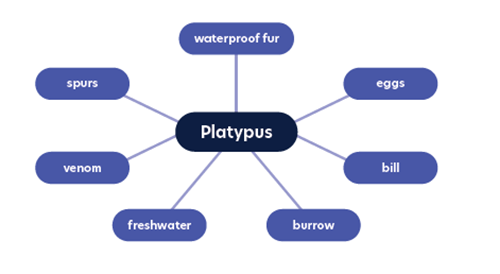
Repeat the process with other animals from the text as a whole group.
Alternatively, have small groups of students create semantic word webs about an animal from the text and share them with the whole group.
Australian Curriculum links
Reflecting on learning
Help students ‘bring it all together’ and reflect on their understandings by completing the graphic organiser either independently or with a partner.
Venn diagram
Talk about the four animals that the text focused on. Ask students to think about the ways in which the animals are the same and how they are different. Discuss as a group.
Print the Venn diagram worksheet for students to complete.
For families - new for 2024!Reinforce your classroom learning by telling families in your class about What Am I? Amazing Australian Animals. Families can share the text at home and use the information provided to build knowledge and instill a love of reading. Find out more about What am I? Amazing Australian Animals (for families) |
